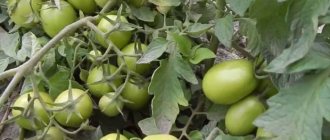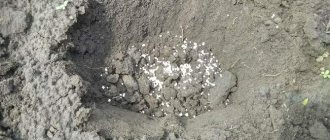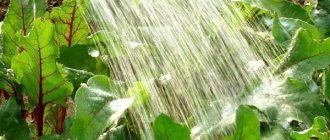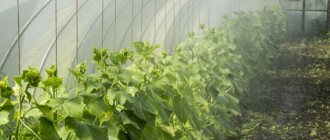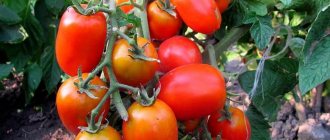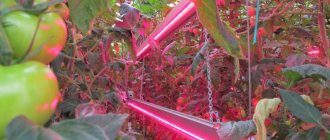The opinion is firmly rooted that tomatoes love water very much; without artificial irrigation there is no point in growing them. However, not every summer cottage has a source of water, not to mention a main water supply. Atmospheric precipitation is an unpredictable phenomenon; there is no point in counting on rain. Difficulties with watering often force summer residents to give up growing their favorite crops.
What is the essence of the method of growing tomatoes without watering?
Regular watering does not in any way stimulate the root system of tomatoes to develop - they are supplied with food and water regularly, often in excess. In such comfortable conditions, until the beginning of fruiting, there is no incentive for the plant to penetrate deeper with its roots. At the time of fruit development, the body’s needs increase - the roots begin to look for water and nutrition, i.e., the development of the root system occurs with a significant delay.
At this moment, growing the root system is a priority for the plant—fruiting is somewhat delayed, and the yield in quantitative terms is reduced.
To avoid this, there is an agricultural technique - growing tomatoes without watering; a developed root system is formed long before fruiting. Such roots can “nourish” not only the tomato bush itself, but also a rich harvest.
Which crops do not require special care?
The fact that you will have the opportunity to visit the site 2-3 times a month is already good. With this regime, you don’t have to give up your garden by planting more or less drought-resistant plants.
The first thing that comes to mind is melons. Watermelons can grow without watering. And if you water them once or twice a month after they grow and take deep roots, a harvest is guaranteed.
The problem is different: you need to take care of the safety of the crop. The fact is that ripening watermelons like to be pecked by crows, magpies, and rooks. And you need to think about protection: hide the fruits under the grass, cover them with non-woven material on the arches.
Melons and pumpkins can also get by with infrequent watering; they also require minimal care. You can sow sweet corn and tomatoes.
Sunflowers are content with occasional watering, but it is better to avoid sowing them. This crop greatly depletes the soil. In addition, you may not see the seeds: sparrows like to feed on sunflower caps.
Plants are prepared for the fact that they will have to exist in arid conditions from the first days. Weed the seeding furrows well, sow the seeds, wait for the shoots to emerge, and don’t rush to water: let the seedlings take root deep and seek moisture. After such “asceticism” in the initial period, plants can easily get by with rare watering during the period of active growth and fruiting.
Try to keep the soil moist
Still, it’s worth thinking about how to keep the soil moist from watering to watering. Think about mulching. Last year's leaves, dried mowed grass, straw, and old sawdust will be used.
Mulching is also necessary because the soil on your site is sandy loam: it quickly overheats and dries out. When weeding the grass regularly, leave it in the spaces between the rows of the beds, on paths, under bushes and trees.
Overgrown grass can be chopped with a shovel so that it covers the soil more evenly, protecting it from overheating and drying out. It is important that the layer of mulch initially prevents the growth of weeds, and later, as it decomposes, it improves the structure of the soil and enriches it with nutrients. You can also cover the soil with sheets of cardboard or non-woven material.
Read also: The best vegetable seeds
Radishes, lettuce, and dill sown under film in early spring can easily get by with spring moisture and watering during your rare visits to the dacha. You can even plant some early potatoes.
A bed of potatoes covered with mulch will need to be watered less.
Try to plant the germinated tubers deeper than usual, and after germination, only lightly hill up the plants, forming irrigation grooves. Highly hilled potatoes require frequent watering because the soil in the ridges dries out quickly, so this agricultural technique is not for a garden that will be watered occasionally. Even before the onset of hot weather, the potato bed must be mulched.
The simplest drip irrigation systems
You can even plant a few pepper bushes or eggplants by building a small round bed for them. A water container is dug into the center of the bed. Long braids are woven from narrow strips of fabric, one end of which is lowered into a container of water, and the other is placed near a pepper or eggplant bush.
How many plants are planted around the circumference of the bed, so many braids. Then the braids are sprinkled with earth. The container is filled with water and covered with a lid. The braids, when wet, will moisten the soil in the garden bed during your absence.
You can keep the soil moist in other ways. For example, dig plastic bottles near each bush, making holes in them through which water will slowly seep. Such simple watering systems will help reduce plant care to a minimum.
When planting seedlings, you can add perlite to each hole and mix it with the soil. Perlite granules immediately after watering absorb excess moisture from the soil, and as it dries, they gradually release it. Perlite holds four times its weight in water.
Sow green manure
If you still decide that it will not be possible to grow vegetables in the coming season, use the forced downtime to improve the soil. In early spring, areas not occupied by perennial plants can be sown with mustard, oats, and barley.
Before the onset of hot weather, they will form a good green mass even without watering. As soon as the green manure plants are about to bloom, mow them down and do not remove them: let them cover the soil. At the beginning of autumn, green manure can be sown again, expanding the range with winter crops - rye, wheat, which will safely overwinter and in the spring will serve as mulch and soil improver.
Maintaining your garden this way will take you no more time than constant weeding and herbicide treatment. Keeping light soil uncovered by any vegetation all season will ruin it.
Without plant cover, the soil overheats, dries out, and the beneficial microflora in it dies. In addition, light soil is very susceptible to erosion: its top layer is easily blown away by the wind and washed away by melt and rainwater.
Dear visitors to the Dacha Plot, tireless gardeners, gardeners and flower growers. We invite you to take a professional aptitude test and find out whether you can be trusted with a shovel and let you go into the garden with it.
Compliance with the conditions is the main thing in the technique
According to all the laws of nature, “nothing comes from nothing.” It’s the same with tomatoes without watering: if you grow them with reduced water consumption, then the remaining conditions of the tomato garden should be at their best.
The soil
The absence of watering implies the abandonment of liquid fertilizers. This means one thing - the bed for growing tomatoes should be prepared with special care. For autumn digging for every 1 sq. m contribute:
- 7-8 kg (at least a bucket) of humus or compost;
- 0.5 l jar of ash;
- 150-200 g of nitroammophoska.
Rich in nutritious humus, structured soil is the key to the success of tomato farming without watering. The rule applies to both open ground and greenhouses.
It is preferable to fertilize sandy soils during spring digging, so that all the applied fertilizers do not literally go “into the sand.”
Loams retain moisture well - in well-fertilized areas, tomato bushes do well without watering, starting from the moment of planting. If there is a clear lack of nutrition, one-time abundant watering with fertilizing is allowed.
The Prohibition Law can also be broken once during a particularly long drought.
What varieties of tomatoes to choose
Oddly enough, no special preferences are required when choosing a tomato variety. Feel free to experiment with your favorite varieties. The only limitation is that summer residents of the North-West must remember that the period of active fruiting is postponed by 10-14 days.
- Since part of the stem is used to form the root system, there is no point in planting determinate varieties.
- Medium-sized varieties optimally correspond to agricultural technology for obtaining a tomato crop without watering. For an open ground bed, it is better to take varieties of early or mid-early ripening: “King of the Early”, “Bogatyr”, “Cossack”, “Adeline”, “Gina” and many others.
- Without exception, all varieties of greenhouse tomatoes are suitable for growing tomatoes in protected soil: “Darenka”, “Dietary Healthy”, “Hurricane F1”, “Fairy Gift”, “Search F1” and others.
Without watering, salad tomatoes are also suitable for canning; ground and greenhouse tomatoes bear fruit, produce a satisfying harvest, and have a rich taste.
Which vegetables do not require attention?
Some vegetables can even be grown on the balcony in winter. Such vegetables include zucchini, beans and cucumbers, and squash . These plants produce a large harvest and do not need to be watered regularly.
Tomatoes have a huge number of varieties. There are special varieties that do not require special care. It is better to choose a variety that is intended for growing indoors. Such tomatoes are sweet and not, they require special care and light.
Cucumbers . It is best to choose varieties that will bear small fruits. It is necessary to plant such plants at a great distance from each other.
Unfortunately, green beans are planted in rare cases. This plant is ideal for busy and lazy people. This plant can be watered irregularly. But in order for the pods to set quickly, you need to constantly collect ripe ones. You can grow the plant in any conditions.
Rhubarb is a plant that deserves its due. This plant is not afraid of anything. You can eat the stems. Even if you visit the dacha occasionally, this plant will grow well.
Also, in determining which plants are best to plant, questions that need to be answered will help:
- what vegetables are most popular in the family;
- whether preservation for the winter is carried out;
- how much time do you have to take care of the city;
- Do the sun's rays hit the garden well?
- what is the climate in the region?
This is the most important thing when choosing vegetables. There are other factors such as soil and drainage. If the site is constantly in the shade and the region is constantly cold and rainy, it is very difficult to achieve the desired result.
Tomatoes without watering - plant according to the rules
The method of obtaining a crop without artificial irrigation will save a lot of time, effort and money. To fully experience the benefits of the method, you must follow certain rules of agricultural technology.
How to prepare seedlings
Tomato bushes should be prepared for growing without watering from the moment they emerge. Young plants are accustomed to lack of moisture from the first days of life. Watering is carried out only if the sprouts wither, preferably through a tray, in order to stimulate the growth of roots into the depth of the container with soil.
Advantages of this mode:
- seedlings do not stretch;
- the root system develops;
- a dry microclimate in a seedling box is the best prevention of blackleg and other dangerous diseases.
An important point - when diving seedlings, you should not pinch the root. The root system of a tomato bush can penetrate 1.5-2.0 m deep.
When they reach the age of 50-60 days, the seedlings are planted in open ground or in a greenhouse. For better survival of plants during transplantation, it is necessary to follow a step-by-step sequence of operations.
The bottom pair of leaves of each plant is removed before planting. The bare section of the stem will be needed to form adventitious roots.
Try to keep the earthen ball on the roots - this will speed up the acclimatization process in the new place. If the roots of the seedlings are bare, prepare a clay mash with the consistency of liquid sour cream. Seedlings are dipped in mash until the middle of the stem before being placed in the hole. This ensures maximum contact with the ground.
Preparing the hole
You can’t count on a special tomato harvest without fertilizing - you need to add the following to each hole:
- 4-5 kg of compost or humus without mineral fertilizers;
- 1-2 handfuls of wood ash;
- 1 g pharmaceutical potassium permanganate;
- ½ bucket of water.
Water should be poured into the hole only after mixing all the fertilizers with the soil - the composition must be averaged according to the concentration of the elements.
After absorbing water, the seedlings are laid horizontally with their tops facing north. Up to the middle of the length, the stem is sprinkled with soil, in a layer of no more than 5 cm. It is in the surface layers of the bed that beneficial microorganisms live, which enter into symbiosis with the seedlings.
First and last watering
Carefully pour another ½ bucket of water under the root, being careful not to wet the leaves. This is where the watering ends. Mulch the bed with straw, grass, sawdust - any bulk materials to reduce water evaporation and protect against weeds. The mulch layer should be at least 5 cm
The top of the seedling can be tied to a support or trellis. The holes are placed at a distance of 40-50 cm in rows with row spacing of 80-100 cm. Tomato bushes should receive enough sunlight.
The main thing is not to show pity and not to water the garden bed after 2-3 days, when the water in the hole is used up and the tomatoes begin to wither. A lack of water will accelerate root formation on the horizontal part of the stem - in 1-2 weeks everything will return to normal, the seedlings will “come to life”.
In the video you can see how tomatoes grow that were not watered, not fertilized, and no growing technology was followed.
Country stories
My family loves homemade food. Canned pickles, salads, and snacks are not served on the table in winter. I grow vegetables both in a greenhouse and in open ground. I think that I have gotten the hang of this difficult matter. Little tricks help:
- When the temperature drops, I water only manually with warm water.
- In hot summers, I increase the number of approaches to 2 times a day (morning and evening); on rainy days, I leave the tomatoes until the soil dries out.
- I grow seedlings of elite varieties in a greenhouse using a drip irrigation system.
- The X-Hose hose has become a faithful assistant in caring for adult plants. Lightweight, gives good water pressure, does not wash out roots.
Read also: Cold pickling of green tomatoes in a saucepan (recipes)
